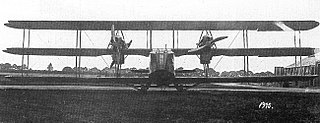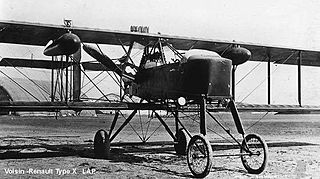Operators
 France
France
| Voisin Type VI | |
|---|---|
| Role | Bomber |
| National origin | France |
| Manufacturer | Société Anonyme des Aéroplanes G. Voisin |
| First flight | 1916 |
| Number built | approximately 50 |
| Developed from | Voisin V |
The Voisin VI or Voisin Type 6 [1] was a French pusher biplane bomber aircraft of World War I. [2]
The first Voisin Type VI entered service in 1916 and replaced the Voisin III on the production lines. However, the Voisin 155 hp (116 kW) (as they were referred to at the Western Front) Salmson engines were held in low regard by their crews. [1] Despite the more powerful engine, the Voisin Type VIs' payload was only marginally better and the maximum speed was only 113 km/h (70 mph; 61 kn) - not enough of an improvement to make a difference, while climb rate suffered substantially. [3]
A single Voisin Type VI was fitted with a second Salmson in the nose of the fuselage, driving a tractor propeller. It is believed that the intention was to test a possible twin pusher and tractor propeller configuration for a new bomber planned by Voisin.
Approximately 50 Voisin Type VIs were built, and these served alongside the Voisin Type IIIs in front-line escadrilles during 1916.
Data from [4]
General characteristics
Performance
Armament

The Zeppelin-Staaken R.VI was a four-engined German biplane strategic bomber of World War I, and the only Riesenflugzeug design built in any quantity.

The Voisin III was a French World War I two-seat pusher biplane multi-purpose aircraft developed by Voisin in 1914 as a more powerful version of the 1912 Voisin I. It is notable for being the aircraft used for the first successful shooting down of an enemy aircraft on October 5, 1914, and to have been used to equip the first dedicated bomber units, in September 1914.

The Bristol Braemar was a British heavy bomber aircraft developed at the end of the First World War for the Royal Air Force. Only two prototypes were constructed.

The Friedrichshafen G.IV and G.V respectively were heavy bombers that were designed and manufactured in Germany during World War I by Flugzeugbau Friedrichshafen. The G.IV saw limited use by the Luftstreitkräfte for tactical and limited strategic bombing operations, while the G.V and a follow-on design, the FF.62 did not fly until after the Armistice.

The Voisin V was a French pusher-type bomber aircraft of World War I.

The Gotha WD.14, WD.20, and WD.22 were a family of biplane torpedo bomber floatplanes developed in Germany during World War I.

The Short Type 827 was a 1910s British two-seat reconnaissance floatplane. It was also known as the Short Admiralty Type 827.

The Besson H-5 was a French transport quadruplane flying boat designed by the Marcel Besson company of Boulogne. The only H-5 was damaged and development was abandoned.

The Lioré et Olivier LeO H-180 was a 1920s French two-seat flying-boat built by Lioré et Olivier.

The Zeppelin-Staaken R.XVI(Av) was a very large bomber (Riesenflugzeug), designed and built in Germany during 1918.

The Zeppelin-Staaken Riesenflugzeuge were a series of very large bomber aircraft - Riesenflugzeuge, usually powered by four or more engines, designed and built in Germany from 1915 to 1919.

The Henry Farman HF.30 was a two-seat military biplane designed in France around 1915, which became a principal aircraft of the Imperial Russian Air Service during the First World War. Although it was widely used on the Eastern Front, and by the factions and governments that emerged in the subsequent Russian Civil War, it is not well known outside that context: the HF.30 was not adopted by other Allied air forces, and the manufacturers reused the "Farman F.30" designation for the Farman F.30 in 1917.

The Loire 30 a.k.a.Loire 300 was a French three-seat night reconnaissance monoplane designed and built by Loire Aviation of St. Nazaire.

The Voisin Triplanes were large experimental bombers built by Voisin in 1915 and 1916. After unsuccessful trials of the 1915 prototype a modified version with more powerful engines was built in 1916, as the Voisin E.28, but the type did not enter production.

The Nieuport 15 was a French World War I bomber aircraft. Due to disappointing performance the type was rejected and never entered service.

The Voisin VIII was a French two-seat biplane pusher which was built in two versions, one fitted with a 37mm Hotchkiss cannon, and the other as a conventional bomber. Problems with the Peugeot engine led to a short operational career with front line units before being superseded by the Voisin X, which aside from the installation of a new Renault engine, was nearly identical to the VIII.

The Voisin X was a French two-seat pusher biplane which was built in two versions, one fitted with a 37 mm (1.46 in) Hotchkiss cannon, and the other as a conventional night bomber. Problems with the Peugeot engine in the previous Voisin VIII led to the installation of a new Renault engine of greater power and reliability, but the new aircraft was otherwise nearly identical to the VIII. Despite its obsolescence, it would make up the bulk of front line night bomber escadrilles until the end of the war.

The Bréguet XI was a prototype French biplane bomber of the First World War.

The Voisin XII was a prototype French two-seat four-engine biplane bomber built near the end of the First World War but which did not enter service.

The Voisin IV was a French two-seat bomber and ground attack aircraft of World War I.
| Wikimedia Commons has media related to Voisin aircraft . |